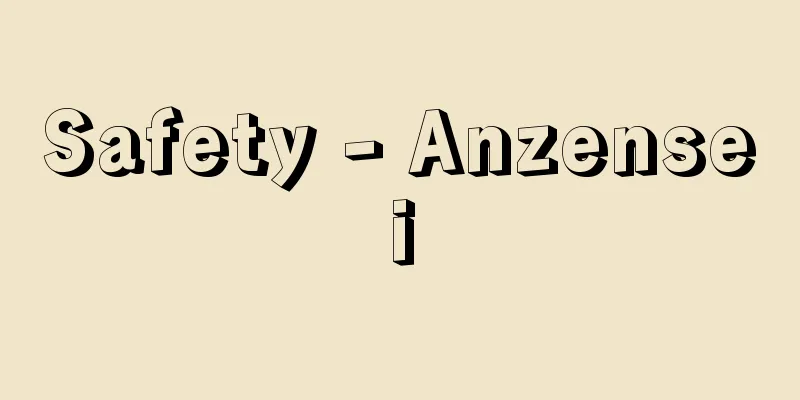Safety - Anzensei

|
Safety means that there is no harm to health, life, property, the natural environment, etc. from accidents, disasters, crimes, etc., and the difficulty (degree) of harm occurring is called safety. Although the scope of the subject is extremely broad, here we will discuss the fundamental points for preventing harm from occurring and increasing safety, mainly in relation to industrial production. [Ishitani Kiyomoto] Basic issues and principles of safetyEven in the home, which is considered a safe place, there are accidents such as small children falling into the bathtub and drowning, which shows that absolute safety in the strict sense is impossible. On the other hand, as seen in the example of rigid airships that were the final nail in the coffin with the Hindenburg disaster, things that are too dangerous will be eliminated. When considering safety from the standpoint of "absolute safety is impossible" and "things that are too dangerous will be eliminated," the two basic questions are: (A) how safe should we be, and (B) how can we improve safety? However, as is clear from the fact that (1) safety changes depending on technological, social, and natural conditions, and (2) even when these conditions are given, many accidents and disasters occur for completely unexpected reasons, there are two principles: uncertainty due to the finiteness of human knowledge is always present, and differences due to differences in the positions of the people involved in the event (generally the difference between the developer, the recipient, and a third party; for example, the difference between the seller, the buyer, and a third party, or the perpetrator and the victim), making it inherently difficult to give a clear answer to the basic problem of evaluating safety. [Ishitani Kiyomoto] Safety technology as a rule of thumbPrimitive people would have been injured while making stone tools or building houses. Bridges would have collapsed and boats would have capsized during ancient civilizations. In other words, the history of safety is as long as the history of human beings. From the beginning of production technology, it was necessary to reproduce not only tools and facilities but also labor to maintain production. Therefore, technologies with so many accidents and disasters that the amount of direct and indirect labor required to produce a certain good could not be reproduced were eliminated. Even in slave labor that ignores human rights, excessive disregard for safety is not economically possible, and the common human instinct to avoid death and injury naturally comes into play, although there are differences depending on the strength of the idea of human rights. In other words, the law holds that safety (or, conversely, danger) is incorporated into production technology while taking into account the social and natural conditions of the time. However, because the way it is incorporated into technology is empirical, it is not easy to answer the two basic questions above, and it is even more difficult to find the actual safety (danger) from the ancient records of the rulers. The Kanayagogami, enshrined at the ancient Japanese tatara ironworks, is an exception in Shintoism in that it is said that he did not hesitate to be impurified by death, and rather rejoiced in it, and the fact that the enshrined Ama-me Hitotsu god has only one eye symbolizes the unsafety of ancient ironworks. Other examples that speak of safety (danger) include the chain graves of convict laborers who died during the construction of the railway, which was the front line of Hokkaido's development in the Meiji period, and the Sadler Report, which motivated the adoption of the Factory Act in England in 1833 and stated that "slavery exists in the country." These are also examples that recall the safety (danger) of ironworks. However, regardless of the actual situation, the level of safety required at the time is crucial to the fate of the technology in question. From this, a rule of thumb has been established in the history of safety technology, which is as old as mankind itself. This is the principle that "the safety of new technology cannot be easily trusted until proven results are seen." If we apply this principle to the current situation, when adopting new technology, the method used for mass-produced products is to conduct thorough practical tests on prototypes before releasing them to the market, and for cutting-edge technology, such as space development, the method used is to first launch only the machine, then conduct space flight experiments with monkeys and dogs, and then have specially trained astronauts fly for a short time, gradually extending the flight time.In contrast to these, nuclear power generation is a technology that has caused safety problems by becoming obsessed with theory before any results have been obtained, and by prioritizing speed of development. Generally, improving safety requires money and effort, but there are many examples that reveal the wisdom of the ancients in striking a balance between safety and the need for it. For example, in the case of tatara iron smelting, local farmers were employed in jobs that did not require a high level of skill, providing them with a means of earning cash income, and in return, river pollution caused by the collection of iron sand was accepted, and the period for collecting iron sand was limited to the period from the autumn equinox to the spring equinox, reducing damage to rice paddies. [Ishitani Kiyomoto] Third-party inspection systemThe long-distance voyages of the 16th century, which developed from the adventurous voyages of the 15th century, brought huge profits if successful, but also great dangers, and for this reason the marine insurance business was established by 1547. Since insuring dilapidated ships would cause great damage to insurers, private entrepreneurs tried and tried hard, and in 1834 Lloyd's Register of Shipping was established in the UK. A classification society is not a manufacturer, user, licensing authority, crew representative, or insurance company, but a purely third-party organization with dedicated and competent inspectors who do not simply examine documents but also conduct fair inspections of the actual ships and give a class to ships that they judge to be acceptable. The judgment has official international authority, and ships without a class are not insured and no crew members are allowed to board them, so they are ultimately unable to sail. This system spread to other major maritime countries, and the Nippon Kaiji Kyokai was established in Japan. Generally speaking, third parties with no vested interest can only remain bystanders, but the creation of a system that enables such third parties to be inspection organizations that have inspectors who are as competent as the specialized engineers at shipyards and shipping companies and that maintain a strictly impartial stance can be considered a major innovation in safety technology. In any case, it is difficult for the parties themselves to make a fair judgment, and differences in position exist throughout all professions, with scientists and engineers being no exception. This is clear, for example, when the scientific expert reports submitted by the two parties in pollution lawsuits show opposing findings. The third-party inspection system resolved the contradiction between this situation and the need for specialized academic knowledge and experience. From the latter half of the 18th century, various industrial accidents began to occur frequently due to the progress of the Industrial Revolution and technological development. The most notable was boiler explosions from the beginning of the 19th century. The number of accidents in which a boiler that had been in use without any problems until the day before suddenly exploded and caused serious damage increased sharply, reaching 400 cases per year in the United States in 1901. In order to prevent such accidents, the following were proposed: (1) regulating materials, structure, and workmanship (for example, limiting the use of brittle and weak materials such as cast iron to boilers that operate at low pressures similar to atmospheric pressure); (2) providing redundancy to important auxiliary equipment (installing duplicates so that if one fails, the other can take care of it); (3) installing various safety devices (for example, installing safety valves that automatically release steam and adjust pressure if the pressure becomes too high); and (4) introducing a third-party inspection system. Although (4) had been proven to be effective on ships, it had to be rediscovered on land. From the beginning of the 20th century, when the above four measures were applied to all boilers in various countries, the boiler burst problem that had lasted for a century was suddenly resolved. In Japan, the take-off to a modern industrial society was delayed, and since the Meiji era the industrial system has been led by government agencies. Compared to the maritime industry, the country has been less internationalized, and as a result, in the land sector, government agencies still have inspection departments for each licensing department, and third-party inspection organizations with international authority are underdeveloped. Reforming the government organization is considered extremely difficult, but calls for improving the current system are beginning to be made. [Ishitani Kiyomoto] Probability distribution law of safety-related eventsThe frequency rate of industrial accidents in Japan (the number of deaths and injuries per 1 million total working hours) gradually decreased from 4.77 to 3.59 between 1975 (Showa 50) and 1980, but if we consider the working hours of one worker as 2000 hours per year (8 hours per day x 250 days), the decrease was not so great, from 1% to 0.7% per person per year. As of 2001 (Heisei 13), the frequency rate of industrial accidents had improved considerably to 1.79, or 0.4% per person per year. In terms of the classification of fatal and injury accidents by type in 1979, the top five were "being caught or caught in something," followed by "falls," "flying objects," "tripping," and "cuts and abrasions," which together accounted for 71% of all fatal and injury accidents. In 2001, the top five accidents were "falls," "being pinched," "being caught," "tripping," "cuts," and "flying objects," which together accounted for 70% of all fatal and injury accidents. There have been some changes in the rankings and ratios, but not drastic changes. The proportion of all fatal and injury accidents caused by these five accidents was almost 70% in 1979 and in 2001, about 20 years later. In other words, although each individual accident is unique, looking at the bigger picture, the distribution of the probability of occurrence of safety-related events such as disasters, accidents, breakdowns (a state in which equipment is unable to perform its specified capabilities), and damage (a state in which equipment that was working properly is opened and parts that need repair are found) is very unlikely to change, despite the efforts of those involved. Generally, disasters and accidents do not occur due to a single cause, but only when two or more causes overlap. Furthermore, the probability of occurrence increases in the following order: major disasters, minor disasters, accidents, breakdowns, and damage. In other words, major disasters do not occur suddenly, but there are always warning signs. The saying "Frost leads to hard ice" also applies to safety-related events. [Ishitani Kiyomoto] For improved safety(1) The enormous productivity of today can be a factor in the expansion of disasters. It would be desirable to make the probability of a major disaster inversely proportional to the square of its scale, but achieving this would require enormous effort. (2) There is a limit to the scale of disasters that can be discussed in terms of probability. The probability of a large-scale disaster that could destroy all of humanity must be reduced to absolutely zero. (3) Regarding safety, even if you think you have taken all necessary measures, accidents will occur eventually unless you eliminate the causes, just as in the case of eliminating level crossings by building an overpass in order to eliminate level crossing accidents. (4) As human rights have expanded, the amount of compensation that perpetrators must pay to victims has increased. It is also true that this has been an important driving force behind improved safety. [Ishitani Kiyomoto] "The Science of Safety - New Technology Prepares for New Accidents" by Noriyuki Sakigawa (1970, Diamond Publishing) ▽ "The Safety of Large-Scale Technology - Are Accidents and Disasters Inevitable?" edited by the Large-Scale Technology Safety Group of the Institute of Applied Energy (1987, Denryoku Shimposha)" ▽ "Safety Assessment Methods" edited by the Architectural Institute of Japan (1987, Shokokusha) ▽ "The Nuclear Energy Choice - Its Safety and Accident Examples" by John G. Collier and Geoffrey F. Hewitt, translated by Nakanishi Shigeyasu et al. (1992, Corona Publishing) ▽ "Safety of Machinery - Basic Concepts and Design Principles", "Safety of Machinery and Equipment - Emergency Shutdowns and Design Principles", "Safety of Machinery - Principles of Risk Assessment" edited by the International Organization for Standardization (1993, 1996, 2000, Japanese Standards Association)" ▽ "Why Do Planes Crash? - The Safety of Aviation Systems from a Designer's Perspective" by Hiroshi Endo (1994, Kodansha) ▽ "Japan Society of Mechanical Engineers, ed., 'Automation of Logistics Systems Today -- Considering Safety', 'Streamlining Plant Design and Improving Safety' (1997, Maruzen Publishing)" ▽ "Mitsuo Taketani, 'Thinking About Safety' (Iwanami Shinsho)" [References] | | | | | | | | | | |Source: Shogakukan Encyclopedia Nipponica About Encyclopedia Nipponica Information | Legend |
|
健康、生命、財産、自然環境などに、事故、災害、犯罪などの危害が及ばないことを安全といい、危害の発生のしがたさ(度合い)を安全性という。対象とされるものはきわめて広範であるが、ここでは、危害の発生を防止し、安全性を高めるための原理的な事項について、主として工業生産にかかわって述べる。 [石谷清幹] 安全性の基本問題と原理安全な場所とされる家庭においてさえも、幼児が浴槽に落ちて溺死(できし)するといった類(たぐい)の事故があるということは、厳密な意味での絶対安全がありえないことを示している。一方、かつてのヒンデンブルク号の惨事でとどめを刺された硬式飛行船の例にみられるように、危険すぎるものは淘汰(とうた)される。この「絶対安全はありえない」「危険すぎるものは淘汰される」という2点に立脚して安全性を考えるとき、(A)どこまで安全であればよいか、(B)どうすれば安全性を改善できるか、この2点が基本問題となる。 ところが、(1)安全性は技術、社会、自然の諸条件により変化する、(2)これら諸条件が与えられても、まったく思いがけないことから多くの事故や災害が起こる、ことで明らかなように、人知の有限性による不確実性がつきまとうことと、その事象に関係する人の立場の差(一般的には展開者と受容者と第三者の差。例示的には売り手と買い手と第三者、あるいは加害者と被害者などの差)による差異がつきまとう、という二つの原理があり、安全性の評価という基本問題に明確な解答を与えることは本質的に困難なのである。 [石谷清幹] 経験則としての安全技術原始人も石器の生産や住居の建設中に負傷したであろう。古代文明期にも橋が落ちたり、舟が転覆したであろう。つまり安全性の歴史は人間の歴史と同じ長さをもつ。生産技術の始まった当初から、生産の維持には道具や施設とともに、労働力も再生産されることが必要であった。したがって、ある財の生産に要した直接・間接の労働量の再生産もできないほど事故や災害の多い技術は淘汰されてきた。人権無視の奴隷労働といえども、度を過ぎた安全無視は経済上からもできないし、これに死や負傷を忌避する人間共通の本能が、人権思想の強弱による差異を伴いつつも当然作用する。つまり、安全性(逆にいえば危険性)は、その当時の社会的自然的条件を前提としつつ、生産技術のなかに組み込まれる、という法則が成り立つのである。 しかし、技術への組み込まれ方が経験的であるため、前記の2点の基本問題に答えることは容易ではなく、まして支配者側の古記録から安全性(危険性)の実態を探ることは困難である。日本古来のたたら製鉄場に祀(まつ)られた金屋子神(かなやごがみ)が、神道では例外的に死の穢(けがれ)をいとわず、むしろ喜んだとされること、合祀(ごうし)される天目一個(あまめひとつ)神の目が一つであることは、古代製鉄の不安全さを象徴するものであろう。また明治期の北海道開拓の前線となった鉄道建設で死んだ囚人労働者の鎖塚(くさりづか)の例や、1833年にイギリスで工場法が採択される動機となったサドラー報告が「国内に奴隷制がある」とした例なども、安全性(危険性)を物語るものとして想起される。 しかし、どのような実態であったとしても、その時点で必要とされるだけの安全性は、その当時の当該技術の死命を制する重要性をもつ。そこから、人類史と同じ古さをもつ安全技術史のなかで、一つの経験則が定着した。それは、「実績が出るまでは軽々に新技術の安全性を信用できない」とする原則である。 この原則を今日の実状に照らしてみると、新技術の採用に際しては、量産品では、試作品による徹底的な実用試験を行ったのちに市場に出すという方法がとられ、また先端技術、たとえば宇宙開発では、まず機械だけを打ち上げ、次にサルやイヌを乗せた宇宙飛行実験を行って、その後に特殊訓練を経た宇宙飛行士を短時間だけ飛行させ、漸次滞空時間を延ばすといった方法がとられる。これらとは逆に、実績が出る以前に理論におぼれ、開発の早さを優先させたために安全上の問題を引き起こしたのが原子力発電である。 一般に安全性の向上には費用と手数を要するが、必要な安全性とのバランスのとり方に古人の知恵がうかがえる例も多い。たとえば、たたら製鉄では、高度の熟練を要しない種類の仕事に近在の農民を雇用して現金収入の道を与え、そのかわりに砂鉄採取による河川汚濁が容認され、また砂鉄の採取期間を秋の彼岸から春の彼岸までに限定して水田への被害を軽減した。 [石谷清幹] 第三者検査制度15世紀の冒険航海から発展した16世紀の遠洋航海は、成功すれば巨利が得られたが危険も大きく、そのために海上保険事業が1547年までに成立した。ぼろ船に保険を付与すれば保険業者がこうむる被害が大きいため、民間企業家たちは試行と努力を重ね、1834年にロイド船級協会Lloyd's Register of Shippingがイギリスで設立された。船級協会は、メーカー、ユーザー、許認可官庁、乗組員代表、保険会社のいずれでもなく、純然たる第三者機関で、専属の有能な検査員を有し、検査員は単なる書類審査でなく、現物の船にあたって公正な検査を実施し、自らの判断で合格とした船に船級を与えた。その判定は公的国際的権威をもち、船級のない船には保険も付与されず、乗組員も乗船しないため、結局航行できなくなった。この制度は他の主要海運国に波及し、日本にも日本海事協会がつくられた。 一般的にいえば利害関係のない第三者は傍観者になるしかないが、そうした第三者をして、造船所や海運会社の専門技術者に劣らぬ有能な検査員をもち、しかも厳正中立な立場の検査機関ならしめる制度を創出したことは、安全技術上の一大革新といえる。何事によらず当事者自身には公正な判断は困難で、立場の違いはあらゆる職業を貫いており、科学者や技術者も例外ではありえない。それは、たとえば公害裁判で両当事者からそれぞれ提出される科学的鑑定書が正反対の鑑定結果を示すことによっても明らかである。こうした事情と専門的学識経験の必要性との矛盾を解決したのが第三者検査制度である。 18世紀後半から産業革命の進行と技術の発達により各種の産業災害が多発し始めた。とくに目だったのは19世紀初頭からのボイラー破裂である。前日まで何事もなく使用されていたボイラーがある日突然爆発し、重大災害を引き起こす事故が急増し、アメリカでは1901年には年間400件に達した。そしてこうした事故を防ぐために、(1)材質、構造、工作を規制すること(たとえば、鋳鉄のようなもろくて弱い材料のボイラー本体への使用は、大気圧と同程度の低圧のものに限定する)、(2)重要な付属機器に冗長度をもたせること(二重に設置して、一つが故障しても他方でまにあわす)、(3)各種安全装置をつけること(たとえば、圧力が上がりすぎれば自動的に蒸気を放出して圧力を調整する安全弁をつける)、(4)第三者検査制度を導入すること、などが提案された。この(4)は船舶でその実績が証明されていながら、陸上では新たに再発見されなければならなかった。20世紀初めから各国で前記の四つの対策がボイラーのすべてに適用されると、1世紀にわたったボイラー破裂問題は急転直下解決に向かった。 日本では、近代産業社会への離陸が遅れ、明治以来官庁主導型産業体制であること、海運産業と比べて国際性が弱かったことなどのため、陸上部門ではいまだに官庁が許認可部局ごとに検査部門をもち、国際的権威のある第三者検査機関は未発達である。官庁組織の改定は至難とされるが、現体制改善の主張も出始めている。 [石谷清幹] 安全関連事象の確立分布則日本の労働災害の度数率(延べ労働時間100万時間当りの死傷者数)は、1975年(昭和50)から1980年の間に4.77から3.59に漸減したが、労働者1人の労働時間を年間2000時間(1日8時間×250日)とみると、1人1年当り1%から0.7%への減少で大差はなかった。2001年(平成13)時点では、労働災害の度数率が1.79に、1人1年当りでは0.4%となりかなり好転してきたといえる。また死傷事故の型別分類は、1979年の第1位が「はさまれ・巻き込まれ」、2位が「墜落・転落」、3位が「飛来・落下」、4位が「転倒」、5位が「切れ・こすれ」となり、以上合計が全死傷事故の71%を占めた。2001年では第1位が「墜落・転落」、2位が「はさまれ・巻き込まれ」、3位が「転倒」、4位が「切れ・こすれ」、第5位が「飛来・落下」となり、以上合計が全死傷事故の70%を占めている。この順位や比率に変化はあるが、大幅なものではない。この五つの事故の全死傷事故に占める割合は、1979年もそれから20年ほど後の2001年もほぼ70%である。つまり、個々の災害はいずれも特殊なものであるが、大局的にみれば、関係者の努力にもかかわらず、災害、事故、故障(機器が規定能力を発揮できない状態)、損傷(無事に働いていた機器を開いてみて要修改箇所が発見される状態)などの安全関連事象の発生確率分布は非常に変わりにくいのである。 一般に災害や事故は、単一の原因では発生せず、二つ以上の原因が重なって初めて起こる。さらにその発生は、大災害、小災害、事故、故障、損傷の順に確率が大きくなる。つまり、大災害は突発するものではなく、かならず前兆がある。「霜を踏んで堅氷至る」とは安全関連事象にも当てはまる法則である。 [石谷清幹] 安全性向上のために(1)現代の生産力の巨大化は災害大型化の因子となりうる。巨大災害の発生確率は、規模の2乗以上に反比例させることが望ましいが、その達成には非常な努力を必要とする。 (2)確率で論じうる災害規模にも限界がある。人類全体を破滅させるような大規模災害の確率は絶対にゼロにしなければならない。 (3)安全に関しては、もれなく対策をたてたつもりであっても、たとえば踏切事故をなくすためには立体交差にして踏切をなくしてしまうように、原因を除去しない限り、いつかは事故が発生する。 (4)人権の伸長とともに、被害者に対する加害者の支払うべき賠償金の額が大きくなっているが、これが安全性向上の重要な推進要因となっていることも事実である。 [石谷清幹] 『崎川範行著『安全性の科学――新しい技術が新しい事故を用意する』(1970・ダイヤモンド社)』▽『エネルギー総合工学研究所巨大技術安全グループ編『巨大技術の安全性――事故・災害は不可避か』(1987・電力新報社)』▽『日本建築学会編『安全性の評価手法』(1987・彰国社)』▽『ジョン・G・コリア、ジョフリー・F・ヒューイット著、中西重康ほか訳『原子力エネルギーの選択――その安全性と事故事例』(1992・コロナ社)』▽『国際標準化機構編『機械の安全性――基礎概念、設計原則』『機械設備の安全性――緊急停止、設計原則』『機械の安全性――リスクアセスメントの原則』(1993、1996、2000・日本規格協会)』▽『遠藤浩著『飛行機はなぜ落ちるか――設計者からみた航空システムの安全性』(1994・講談社)』▽『日本機械学会編・刊『物流システムの自動化はいま――安全性に配慮して』『プラントの設計の合理化と安全性の向上』(1997・丸善発売)』▽『武谷三男著『安全性の考え方』(岩波新書)』 [参照項目] | | | | | | | | | | |出典 小学館 日本大百科全書(ニッポニカ)日本大百科全書(ニッポニカ)について 情報 | 凡例 |
<<: Safety lamp - Anzento (English spelling)
>>: Safety education - Anzenkyoiku
Recommend
Gut X-ray examination
Roentgenography is an X-ray examination used to ch...
Miyota [town] - Miyota
A town in Kitasaku District, eastern Nagano Prefec...
Language
… [General Linguistics] His Memoirs on the Primit...
Apparent constitutionalism - Scheinkonstitutionalismus (Germany)
Although it appears to be a form of constitutional...
Esuti tribe - Esuti tribe
The Uralic language family is a collective term f...
Jerusalem artichoke - Jerusalem artichoke
A perennial plant of the Asteraceae family (APG c...
Heartfelt phrase
…5・7・5・7・7 is divided into the top three lines (5...
Foreign currency concentration system
A method of foreign exchange control, a system in...
Sakura doll - Sakura doll
A doll that has been Japanized using French doll-m...
Via Domitia (English spelling)
…stretched from Rome to Reate and later to the Ad...
Study
…These monastery and church architecture in the r...
Masquerade ball - masquerade
A ball where people wear masks or unusual costume...
Géza (English spelling)
...Roman rule ended with the invasion of the Xion...
Li Tong (English spelling)
1093‐1163 A Chinese thinker from the Southern Song...
Shinro-tei
Year of death: 1819 Year of birth: Unknown. A comi...
![Yayoi [town] - Yayoi](/upload/images/67cd0ffb411f5.webp)








